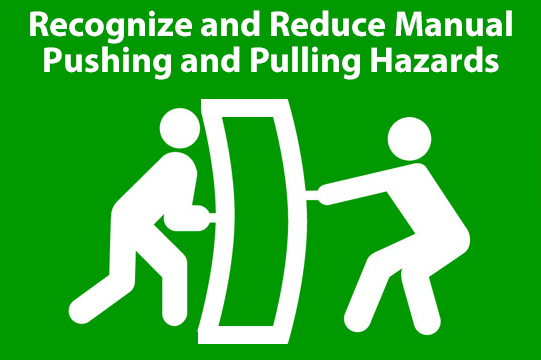Recognize and Reduce Manual Pushing and Pulling Hazards
According to the U.S. Bureau of Labor Statistics, injury and illness cases requiring days away from work remained largely unchanged from the prior year, although overexertion rates increased. Musculoskeletal disorder (MSD) rates also increased compared to 2009. Among others, these losses were experienced by laborers and material movers.
Are your personnel involved in manually moving, pushing, pulling, or transporting materials? Have you identified these terms in the descriptions of any experienced losses? If your answer is “yes” to either question, consider the following guidelines to recognize and reduce your hazards:
1. Look to, or better yet, at your employees. In addition to any difficulties or problems your employees are telling you about, look for the following visual cues as they work:
- Strained facial expressions – it’s possible that their facial expressions may be telling you that their efforts are high or demanding much of their physical capacity.
- Leaning in to it – employees tend to stay more upright when force demands are low, but use their own body weight to get things moving when higher forces are required.
- Somewhat erratic or jerky efforts – quick motions or efforts may be used to generate or halt movement when loads are high or conditions are adverse, as opposed to smooth, fluid, or appearing effortless when forces are low.
2. Look at your workplace conditions. Pushing or moving materials on carts, dollies, or pallet jacks can become more demanding due to multiple turns or changes in direction, narrow aisles, doorways and thresholds, ramps, damaged flooring or expansion joints, or poor housekeeping. Minimize changes of direction and elevation with good planning, layouts, and work methods. Regularly inspect housekeeping and floor conditions.
3. Understand the forces involved. Look at the loads or weights being handled as a general estimate; recommendations for maximum loads have included 500 pounds for four wheel carts and 1,500 pounds for manual pallet jacks. That said, push or pull forces are typically not the same as the weight of the load being moved. Under the most favorable of conditions (i.e., smooth level surface, well maintained carts, wheels aligned in direction of travel) forces may be as low as 2% of the load weight. Forces quickly rise when these conditions are not met. Consider measuring the actual forces using a tension pull gauge possibly found in your maintenance shop. Recommended force levels have included:
- 50 pounds or less to start the cart, dolly, or other device in motion.
- 40 pounds or less to keep a device moving.
- 25 pounds or less when the force has to be sustained for more than a minute or the device has to be pushed more than 10 feet.
Maximum recommended forces can change depending on handle heights, distances, frequency, gender, age, and percent of population you are trying to accommodate. Commonly, at least 75% of females should be able to perform the manual material handling work without undue strain or fatigue.
4. Train employees to push as often as possible. Pushing allows employees to better utilize their body weight when higher forces are required. Pushing with both hands also helps to minimize twisting and reaching. Acceptable forces can be to be up to 20% higher when pushing as opposed to pulling, and pulling, more so the pushing has been found to increase compressive loading of the spinal discs. Train employees to identify the swivel wheels or casters on some carts and push from that end; forces required to turn the carts should be lower. Consider labeling the associated handle, “Push From This End,” or remove the opposite handle to eliminate any possible confusion.
5. Perform preventative maintenance on equipment. Regular preventative maintenance is critical for bearings and other components to operate as efficiently as designed and intended. Consider going beyond any recommendation provided by the manufacturer or supplier, as instruction is limited depending on the device.
6. Consider powered equipment. If loads are heavy, forces and frequencies are high, distances are long, or injuries continue to occur, consider providing powered equipment. When looking for possible equipment, know your exposures and facility conditions; consider any limitations in space, aisle width, floor capacities, etc; consider associated requirements of inspection, storage, charging, eyewash stations, etc; and your budget.
If further assistance is needed, contact your loss control consultant and check out the following resources:
- Getting to Grips with Manual Handling
- Ergonomic Guidelines for Manual Material Handling
- Hand Trucks (Used in Beverage Industry)


